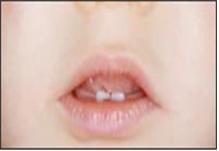티징(생치/치생) Teething
- 첫 젖니가 생후 3~12개월 사이에 나는 것이 보통이다.
- 생후 6~36개월 사이에 다음과 같은 순서로 젖니가 나는 것이 보통이다.
- 아래 두 중앙앞니, 위 두 중앙앞니, 위 양쪽 옆 앞니, 아래 양쪽 옆 앞니, 아래 양쪽 첫 어금니, 위 양쪽 첫 어금니, 아래 양쪽 송곳니, 위 양쪽 송곳니, 아래 양쪽 두 어금니, 아래 양쪽 2번째 어금니, 위 양쪽 두 번째 어금니 순서로 이가 난다.
- 생후 6~36개월 사이 영유아들에게 젖니가 날 때 열, 두통, 설사, 기침, 기저귀 피부염, 감기, 심한 울음, 경련, 기침 등의 증상 징후가 생길 수 있다고 믿는 부모들이 많다.
- 이런 증상 징후들을 티징(생치/치생/Teething)이라고 한다. 그렇지만 대부분의 경우 그런 티징 증상 징후가 생기지 않는다.
- 티징으로 침 흘림, 경미한 잇몸 통증, 잇몸 불편, 무엇을 씹으려고 하는 증상 징후 등이 경미하게 생길 수 있다.
- 그러나 티징으로 심히 보채고 울고 수유를 중단할 정도 불편한 증상 징후는 생기지 않는다.
- 이가 날 때 (생치/Teething) 잇몸에 불편감은 느낄 수 있다.
- 이런 증상 징후를 생치(生齒) 곤란, 젖니가 나올 때의 불쾌감 또는 아기 잇몸 살이라고 표현한다.
- 아이들의 영구 대구치는 6~12세에 나는 것이 보통이다.
- 영구 대구치가 나는 잇몸이 조금 붓고 멍들고 조금 아플 수 있으나 역시 일시적으로 생기는 증상 징후이다.
- 잇몸 마사지, 씹을 수 있는 딱딱한 노리개 젖꼭지 등으로 티징을 치료하기도 하지만 사실은 별 치료효과가 없다.
- 이가 날 때 불편한 것 같으면 2~3일 간 경구용 아세트아미노펜(타이레놀)으로 치료 하면 불편하고 아픈 증상이 싹 가신다.
- 티징 젤이나 파레고릭, 또는 그 외 다른 약으로 티징을 꼭 치료할 필요 없다.

사진 21. 이가 날 때
Copyright ⓒ 2011 John Sangwon Lee, M.D., FAAP
Teething 티징(생치/치생)
• It is normal for the first baby teeth to appear between 3 and 12 months of age. • Between 6 and 36 months of age, it is common for baby teeth to appear in the following order.
• Two lower middle incisors, two upper middle incisors, two upper lateral incisors, both lower lateral incisors, both lower first molars, both upper first molars, lower both canines, upper both canines, both lower two molars, both lower second molars, The teeth come out in the order of the second molars on both sides of the top.
• Many parents believe that teething in babies between 6 and 36 months of age can cause symptoms such as fever, headache, diarrhea, cough, diaper dermatitis, colds, heavy crying, convulsions, and coughing.
• These symptoms are called teething. However, in most cases there are no signs of such teasing.
• Teasing can cause mild drooling, mild gum pain, gum discomfort, and signs of chewing.
• However, the teasing does not cause severe irritation, crying, and uncomfortable symptoms enough to stop breastfeeding.
• When teething (teething), you may feel discomfort in your gums.
• Describe these symptoms as difficulty in brushing teeth, discomfort when teething, or baby gums.
• It is common for children to have permanent molars between the ages of 6 and 12.
• Permanent molar gums may be slightly swollen, bruised, and painful, but these are also temporary symptoms.
• Teasing is sometimes treated with a gum massage or chewable pacifier, but in fact, it is not very effective.
• If you feel uncomfortable when teething, treatment with oral acetaminophen (Tylenol) for 2 to 3 days will relieve the uncomfortable and painful symptoms.
• It is not necessary to treat teasing with teasing gel, paregoric, or any other drug.

Photo 21. When teething Copyright ⓒ 2011 John Sangwon Lee, M.D., FAAP
출처 및 참조 문헌 Sources and references
- NelsonTextbook of Pediatrics 22ND Ed
- The Harriet Lane Handbook 22ND Ed
- Growth and development of the children
- Red Book 32nd Ed 2021-2024
- Neonatal Resuscitation, American Academy of Pediatrics
- www.drleepediatrics.com 제 6권 신생아 성장 발육 육아 질병
-
www.drleepediatrics.com제7권 소아청소년 감염병
- www.drleepediatrics.com제8권 소아청소년 호흡기 질환
- www.drleepediatrics.com제9권 소아청소년 소화기 질환
- www.drleepediatrics.com제10권. 소아청소년 신장 비뇨 생식기 질환
- www.drleepediatrics.com제11권. 소아청소년 심장 혈관계 질환
- www.drleepediatrics.com제12권. 소아청소년 신경 정신 질환, 행동 수면 문제
- www.drleepediatrics.com제13권. 소아청소년 혈액, 림프, 종양 질환
- www.drleepediatrics.com제14권. 소아청소년 내분비, 유전, 염색체, 대사, 희귀병
- www.drleepediatrics.com제15권. 소아청소년 알레르기, 자가 면역질환
- www.drleepediatrics.com제17권. 소아청소년 피부 질환
- www.drleepediatrics.com제18권. 소아청소년 이비인후(귀 코 인두 후두) 질환
- www.drleepediatrics.com제19권. 소아청소년 안과 (눈)질환
- www.drleepediatrics.com 제 20권 소아청소년 이 (치아)질환
- Red book 29th-31st edition 2021
- Nelson Text Book of Pediatrics 19th — 21st Edition
- The Johns Hopkins Hospital, The Harriet Lane Handbook, 22nd edition
-
Childhood Emergencies in the Office, Hospital and Community, American Academy of Pediatrics
-
Emergency Medical Service for Children, By Ross Lab. May 1989. p.10
-
Emergency care, Harvey grant, and Robert Murray
-
Emergency Care Transportation of Sick and Injured American Academy of Orthopaedic Surgeons
-
Emergency Pediatrics A Guide to Ambulatory Care, Roger M. Barkin, Peter Rosen
-
Immediate care of the acutely ill and injured, Hugh E. Stephenson, Jr
-
The Critically Ill Child, Diagnosis and Management, Edited by Clement A. Smith
-
Emergency Medical Services for Children: The Role of the Primary Care Provider, America Academy of Pediatrics
-
Quick Reference To Pediatric Emergencies, Delmer J. Pascoe, M.D., Moses Grossman, M.D. with 26 contributors
-
Manual of Emergency Care
-
응급환자관리 정담미디어
-
소아가정간호백과–부모도 반의사가 되어야 한다, 이상원
-
Neonatal Resuscitation American heart Association
-
Neonatology Jeffrey J.Pomerance, C. Joan Richardson
-
Pediatric Resuscitation Pediatric Clinics of North America, Stephen M. Schexnayder, M.D.
-
Pediatric Critical Care, Pediatric Clinics of North America, James P. Orlowski, M.D.
-
Preparation for Birth. Beverly Savage and Dianna Smith
- Infectious disease of children, Saul Krugman, Samuel L Katz, Ann A. Gershon, Catherine Wilfert
-
The Harriet Lane Handbook 19th Edition
-
소아과학 대한교과서
-
제1권 소아청소년 응급의료 참조문헌과 출처
-
Other
Copyright ⓒ 2015 John Sangwon Lee, MD., FAAP
“부모도 반의사가 되어야 한다”-내용은 여러분들의 의사로부터 얻은 정보와 진료를 대신할 수 없습니다.
“The information contained in this publication should not be used as a substitute for the medical care and advice of your doctor. There may be variations in treatment that your doctor may recommend based on individual facts and circumstances. “Parental education is the best medicine.”